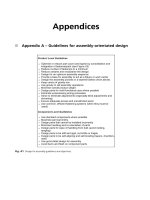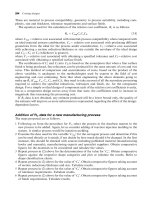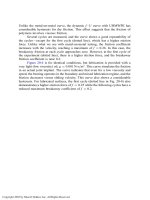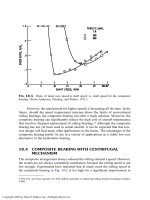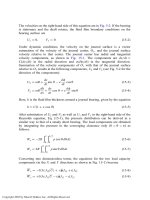Bearing Design in Machinery Episode 2 Part 8 pot
Bạn đang xem bản rút gọn của tài liệu. Xem và tải ngay bản đầy đủ của tài liệu tại đây (273.95 KB, 17 trang )
static radial capacity, C
or
. In Manufacturers’ catalogues, this value is based on a
limit stress of 4.2 GPa (609,000 psi) for 52100 steel and 3.5 GPa (508,000 psi) for
440C stainless steel. The static radial capacity, C
or
, is based on the peak load,
W
max
, on one rolling element as well as additional transient and momentary
overload on the same rolling element during start-up and steady operation.
At these ultimate pressure levels, the assumption of pure elastic deforma-
tion is not completely correct, because a minute plastic (irreversible) deformation
occurs. For most applications, the microscopic plastic depression does not create
a noticeable effect, and it does not cause a significant microcracking that can
reduce the fatigue life. However, in applications that require extremely quiet or
uniform rotation, a lower stress limit is usually imposed. For example, for
bearings in satellite antenna tracking actuators, a static stress limit of only
2.2 GPa (320,000 psi,) is allowed on bearings made of 440C steel. This limit is
because plastic deformation must be minimized for accurate functioning of the
mechanism.
12.4 THEORETICAL LINE CONTACT
If a load is removed, there is only a line contact between a cylinder and a plane.
However, under load, there is an elastic deformation at the contact, and the line
contact becomes a rectangular contact area. The width of the contact is 2a,as
shown in Fig. 12-11. The magnitude of a (half-contact width) can be determined
by the equation
a ¼ R
x
8
"
WW
p
1=2
ð12-2aÞ
FIG. 12-11 Contact area of a cylinder and a plane.
Copyright 2003 by Marcel Dekker, Inc. All Rights Reserved.
Here, the dimensionless load,
"
WW , is defined by
"
WW ¼
W
LE
eq
R
x
ð12-2bÞ
The load W acts on the contact area. The effective length of the cylinder is L, and
E
eq
is the equivalent modulus of elasticity. In this case, R
x
is an equivalent contact
radius, which will be discussed in Sec. 12.4.2. For a contact of two different
materials, the equivalent modulus of elasticity, E
eq
, is determined by the
following expression:
2
E
eq
¼
1 À n
2
1
E
1
þ
1 À n
2
2
E
2
ð12-3aÞ
Here n
1
and n
2
are Poisson’s ratio and E
1
, E
2
are the moduli of elasticity of the
two materials in contact, respectively. If the two surfaces are made of identical
materials, such as in standard rolling bearings, the equation is simplified to the
form
E
eq
¼
E
1 À n
2
ð12-3bÞ
For a contact of a cylinder and plane, R
x
is the cylinder radius. The subscript x
defines the direction of the coordinate x along the cylinder axis. In the case of a
line contact between two cylinders, R
x
is an equivalent radius (defined in Sec.
12.4.2) that replaces the cylinder radius.
The bearing load is distributed unevenly on several rolling elements. The
maximum load on a single cylindrical roller, W
max
, can be approximated by the
following equation, which is based on the assumption of zero radial clearance in
the bearing:
W
max
%
4W
bearing
n
r
ð12-4Þ
Here, n
r
is the number of cylindrical rolling elements around the bearing and
W
bearing
is the total radial load on a bearing. For design purposes, the maximum
load, W
max
, is substituted in Eq. (12-2b) for the calculation of the contact width,
which is used later in the equations of the maximum deformation and maximum
contact pressure.
12.4.1 E¡ective Length
The actual line contact is less than the length of the cylindrical rolling element
because the corners are rounded. The rounded part on each side is of an
approximate length equal to the cylinder radius. For determining the effective
Copyright 2003 by Marcel Dekker, Inc. All Rights Reserved.
length, the cylindrical roller diameter is subtracted from the actual length of the
cylindrical rolling element, L ¼ L
actual
À d.
12.4.2 Equivalent Radius
Equations (12-2) are for a contact of a cylinder and a plane, as shown in Fig. 12-
12. However, in cylindrical roller bearings, there is always a contact between two
cylinders of different curvature. A theoretical line contact can be between convex
or concave curvatures. In all these cases, an equivalent radius, R
x
, of contact
curvature can be used that replaces the cylinder radius in Eq. (12-2a) and (12-2b).
Case 1: Roller on a Plane. As stated earlier, for the simple example of a
contact between a plane and cylinder of radius R (roller on a plane), the
equivalent contact radius is R
x
¼ R.
Case 2: Convex Contact. The second case is that of a convex line contact
of two cylinders, as shown in Fig. 12-13. An example of this type of contact is
that between a cylindrical roller and the inner ring race. The equivalent contact
radius, R
x
, that is substituted in Eqs. (12.2a and b) is derived from the following
expression:
1
R
x
¼
1
R
1
þ
1
R
2
ð12-5Þ
Here, R
1
and R
2
are the radii of two curvatures of the convex contact, and the
subscript x defines the direction of the axis of the two cylinders.
Case 3: Concave Contact. A concave contact is shown in Fig. 12-14. An
example of this type of contact is that between a cylindrical rolling element and
the outer ring race. For a concave contact, radius R
1
is negative, because the
contact is inside this circle. The result is that the equivalent radius is derived
FIG. 12-12 Case 1: roller on a plane.
Copyright 2003 by Marcel Dekker, Inc. All Rights Reserved.
12.4.3 Deformation and Stresses in Line Contact
For a line contact, the maximum deformation of the roller in the direction normal
to the contact area (vertical direction in Fig. 12-11) is
d
m
¼
2
"
WWR
x
p
ln
2p
"
WW
À 1
ð12-7Þ
According to Hertz’s theory, there is a parabolic pressure distribution at the
contact area, as shown in Fig. 12-15. The maximum contact pressure is at the
center of the contact area, and it is equal to
p
max
¼ E
eq
"
WW
2p
1=2
ð12-8Þ
12.4.4 Subsurface Stress Distribution
An important feature in contact stresses is that the maximum shear stress is below
the surface. In many cases, this is the reason for the development of subsurface
fatigue cracks and eventually fatigue failure in rolling bearings. Three curves of
dimensionless stress distributions below the surface and below the center of
contact are shown in Fig. 12-16. The maximum pressure at the contact area center
normalizes the stresses. The maximum shear, t
max
, is considered an important
cause of failure. The ratio of the maximum shear stress to the maximum surface
pressure ðt
max
=p
max
Þ is plotted (maximum shear, t
max
, is at an angle of 45
to the
z axis). The maximum value of this ratio is at a depth of z ¼ 0:78a, and its
magnitude is t
max
¼ 0:3p
max
.
FIG. 12-15 Pressure distribution in a rectangular contact area.
Copyright 2003 by Marcel Dekker, Inc. All Rights Reserved.
The contact between the rolling elements and the inner raceway is convex, and
the equivalent contact curvature, R
x;in
is derived according to the equation
1
R
x;in
¼
1
R
roller
þ
1
R
inner raceway
1
R
x;in
¼
1
0:01
þ
1
0:06
) R
x;in
¼ 0:0085 m
However, the contact between the rolling elements and the outer raceway is
concave, and the equivalent contact curvature, R
x;out
is derived according to the
equation
1
R
x;out
¼
1
R
roller
À
1
R
outer raceway
1
R
x;out
¼
1
0:01
À
1
0:08
; R
x;out
¼ 0:0114 m
If we assume that the radial clearance between rolling elements and raceways is
zero, the maximum load on one cylindrical rolling element can be approximated
by Eq. (12-4):
W
max
¼
4W
bearing
n
¼
4ð11;000Þ
14
¼ 3142 N
Here, n is the number of cylindrical rolling elements in the bearing, W
bearing
is the
total bearing load capacity, and W
max
is the maximum load capacity of one rolling
element. The shaft and the bearing are made of identical material, so the
equivalent modulus of elasticity is calculated as follows:
E
eq
¼
E
1 À n
2
) E
eq
¼
2:05 Â10
11
1 À0:3
2
¼ 2:25 Â10
11
N=m
2
The dimensionless maximum force at the contact between one rolling element
and the inner ring race is
Inner ring:
"
WW ¼
1
E
eq
R
x;in
L
W
max
¼
1
2:25 Â10
11
 0:0085 Â0:01
 3142
¼ 1:64 Â10
À4
In comparison, the dimensionless maximum force at the contact between one
rolling element and the outer ring race is
Outer ring:
"
WW ¼
1
E
eq
R
eq;out
L
W
max
¼
1
2:25 Â 10
11
 0:0114 Â0:01
 3142 ¼ 1:22 Â10
À4
Copyright 2003 by Marcel Dekker, Inc. All Rights Reserved.
Comparison of the inner and outer dimensionless loads indicates a higher value
for the inner contact. This results in higher contact stresses, including maximum
pressure at the convex contact with the inner ring. The maximum pressure at the
contact with the inner ring race is obtained via Eq. (12-8).
p
max;in
¼ E
eq
"
WW
2p
1=2
¼ 2:25 Â10
11
Â
1:64 Â10
À4
2p
1=2
¼ 1:15 Â10
9
Pa
¼ 1:15 GPa
At the same time, the maximum pressure at the contact with the outer ring race is
lower:
p
max;in
¼ E
eq
"
WW
2p
1=2
¼ 2:25 Â10
11
Â
1:22 Â10
À4
2p
1=2
¼ 0:99 Â10
9
Pa
¼ 0:99 GPa
For regular-speed operation, it is sufficient to calculate the maximum pressure at
the inner contact, because the stresses at the outer contact are lower (due to the
concave contact). However, at high speed the centrifugal force of the rolling
element increases the maximum pressure at the contact with the outer ring race
relative to that of the inner ring. Therefore, at high speed, the centrifugal force is
considered and the maximum pressure at the inner and outer contact should be
calculated.
12.5 ELLIPSOIDAL CONTACT AREA IN BALL
BEARINGS
If there is no load, there is a point contact between a sphere and a flat plane.
Under load, the point contact becomes a circular contact area. However, in ball
bearings the races have different curvatures in the direction of rolling and in the
axial direction of the bearing. Therefore, the two bodies form an elliptical contact
area. The elliptical contact area has radii a and b, as shown in Fig. 12-17.
12.5.1 Race and Ball Conformity
In a deep-groove radial ball bearing, the radius of the deep groove is always a
little larger than that of the ball. A race conformity is the ratio R
r
, defined as (see
Hamrock and Anderson, 1973)
R
r
¼
r
d
ð12-9aÞ
Here, r and d are the deep-groove radius and ball diameter, respectively, as shown
in Fig. 12-18a. A perfect conformity is R
r
¼ 0:5. However, in order to reduce the
Copyright 2003 by Marcel Dekker, Inc. All Rights Reserved.
In the y plane (left-hand cross section), the two radii of contact have a
notation of subscript y. The radii of the curvatures in contact are R
1y
and R
2y
,
respectively. The small radius, R
1y
, is of the rolling ball:
R
1y
¼
d
2
ð12-9bÞ
Here, d is the rolling ball diameter. The concave curvature of the deep groove is
of the somewhat larger radius R
2y
. The equivalent contact radius in the y plane is
R
y
(equal to r in Fig. 12-18a). For a concave contact, the equivalent radius of
contact between the ball and the deep groove of the inner ring race is calculated
by the equation
1
R
y
¼
1
R
1y
À
1
R
2y
ð12-10Þ
The right-hand cross section in Fig. 12-18b is in the y-z plane. This plane is
referred to as the x plane, because it is normal to the x direction. It shows a cross
section of the rolling plane where a ball is rolling around the inner ring. This is a
convex contact between the ball and the inner ring race. The ball has a rolling
contact at the bottom diameter of the deep groove of the inner ring race.
FIG. 12-18b Curvatures in contact in two orthogonal cross sections of a ball bearing
(x-z and y-z planes).
Copyright 2003 by Marcel Dekker, Inc. All Rights Reserved.
In the x plane, the radii of the curvatures in convex contact are R
1x
and R
2x
,
which are of the ball and of the lowest point of the inner ring deep groove,
respectively. The rolling ball radius is R
1x
¼ R
1y
¼ d=2, while the inner ring race
radius at the bottom of the deep groove is R
2x
, as shown on the right-hand side of
Fig. 12-18b. The equivalent contact radius, R
x
, is in the x plane of the convex
contact with the inner ring (the subscript x indicates that the equivalent radius is
in the x plane). The equivalent contact radius, R
x
, is derived from the equation
1
R
x
¼
1
R
1x
þ
1
R
2x
ð12-11Þ
The radius ratio, a
r
, is defined as
a
r
¼
R
y
R
x
ð12-12Þ
This is the ratio of the larger radius to the smaller radius, a
r
> 1. The equivalent
contact radius R
eq
is obtained from combining the equivalent radius in the two
orthogonal planes, as follows:
1
R
eq
¼
1
R
x
þ
1
R
y
ð12-13Þ
The combined equivalent radius of curvature, R
eq
, is derived from the contact
radii of curvature R
x
and R
y
, in the two orthogonal cross sections shown in Fig.
12-18b. The equivalent radius R
eq
is used in Sec. 12.5.4 to calculate the
deformation and pressure distribution in the contact area.
12.5.3 Stresses and Deformation in an Ellipsoidal
Contact
According to Hertz’s theory, the equation of the pressure distribution in an
ellipsoidal contact area in a ball bearing is
p ¼ 1 À
x
2
a
2
À
y
2
b
2
1=2
p
max
ð12-14Þ
Here, a and b are the small radius and the large radius, respectively, of the
ellipsoidal contact area, as shown in Fig. 12-17. The maximum pressure at the
center of an ellipsoidal contact area is given by the following Hertz equation:
p
max
¼
3
2
W
pab
ð12-15Þ
Here, W ¼ W
max
is the maximum load on one spherical rolling element. The
maximum pressure is proportional to the load, and it is lower when the contact
area is larger. The contact area is proportional to the product of a and b of the
Copyright 2003 by Marcel Dekker, Inc. All Rights Reserved.
ellipsoidal contact area. The contact area is inversely proportional to the modulus
of elasticity of the material. For example, soft materials such as rubbers have a
large contact area and the maximum pressure is relatively low. In contrast, steel
has high elasticity modulus, resulting in a small area and high stresses. The
equations for calculating a and b are given in Sec. 12.5.4.
12.5.4 Ellipsoidal Contact Area Radii
The ellipticity parameter, k, is defined as the ratio of the large radius to the small
radius:
k ¼
b
a
ð12-16Þ
The exact solution for the ellipsoid radii a and b is quite complex. For design
purposes, Hamrock and Brewe (1983) suggested an approximate solution. The
equations allow a simplified solution for the deformation and pressure distribu-
tion in the contact area. The ellipticity parameter, k, is estimated by the equation
k % a
2=p
r
ð12-17Þ
The ratio a
r
is defined in Eq. 12-12. The following parameter, q
a
, is used to
estimate the dimensionless variable
^
EE that is used for the approximate solution of
the ellipsoid radii:
q
a
¼
p
2
À 1 ð12-18Þ
^
EE % 1 þ
q
a
a
r
for a
r
! 1 ð12-19Þ
The ellipsoid radii a and b can now be estimated
a ¼
6
^
EEWR
eq
pkE
eq
!
1=3
ð12-20aÞ
b ¼
6k
2
^
EEWR
eq
pE
eq
!
1=3
ð12-20bÞ
Here, W is the load on one rolling element. The rolling elements do not share the
load equally. At any time there is one rolling element that carries the maximum
load, W
max
. The maximum pressure is at the contact of the rolling element of
maximum load.
Copyright 2003 by Marcel Dekker, Inc. All Rights Reserved.
The maximum deformation in the direction normal to the contact area is
calculated by means of the following expression, which includes estimated terms:
d
m
¼
^
TT
9
2
^
EER
eq
W
pkE
eq
!
2
2
4
3
5
1=3
ð12-21Þ
Here, the following estimation for
^
TT is used:
^
TT %
p
2
þ q
a
ln a
r
for a
r
! 1 ð12-22Þ
For ball bearings, the maximum load, W
max
, on one rolling element can be
estimated by the equation
W
max
%
5W
bearing
n
r
ð12-23Þ
Here, n
r
is the number of balls in the bearing. The maximum load, W
max
, on one
ball is substituted for the load W in Eqs. (12-15), (12-20a), (12-20b), and (12-21).
12.5.5 Subsurface Shear
Fatigue failure develops from subsurface cracks. These cracks propagate when-
ever there are alternating stresses and the maximum shear stress is high. It is
important to evaluate the shear stresses below the surface that can cause fatigue
failure.
The following is the maximum value of the shear, t
yz
, in the orthogonal
direction (acting below the surface on a vertical plane y-z; see Fig. 12-18b. In fact,
the maximum shear is in a plane inclined 45
to the vertical plane. However, the
classical work of Lundberg and Palmgren (1947) on estimation of rolling bearing
fatigue life is based on the maximum value of the orthogonal shear stress, t
yz
,
acting on a vertical plane:
t
xy
¼ p
max
ð2t* À1Þ
1=2
2t*ðt* þ1Þ
ð12-24Þ
where the following estimation can be applied:
t* % 1 þ 0:16 csch
k
2
ð12-25Þ
Copyright 2003 by Marcel Dekker, Inc. All Rights Reserved.
12.5.6 Co mment on Precise S olution by Ellipti cal
Integrals
The calculation in Sec. 12.5.4 approximates a complex solution procedure that is
based on the following equations [see Harris (1966)]:
k ¼
2
^
TT À
^
EEð1 þR
d
Þ
^
EEð1 ÀR
d
Þ
"#
1=2
ð12-26Þ
where R
d
is the curvature difference defined by the equation
R
d
¼ R
eq
1
R
x
À
1
R
y
!
ð12-27Þ
The two elliptical integrals are defined as follows:
^
TT ¼
ð
p=2
0
1 À 1 À
1
k
2
sin
2
f
À1=2
df ð12-28Þ
^
EE ¼
ð
p=2
0
1 À 1 À
1
k
2
sin
2
f
1=2
df ð12-29Þ
An iteration method has developed by Hamrock and Anderson (1973) to solve for
the two elliptical integrals and k. The solutions of the elliptical integrals and k are
presented by graphs as a function of the radius ratio a
r
. The use of the graphs or
tables allows a precise solution. However, the approximate solution in Sec. 12.5.4
is sufficient for design purposes.
Example Problem 12-2
Maximum Contact Pressure in a Deep-Groove Ball
Bearing
Find the maximum contact pressure and maximum deformation, d
m
, of a deep-
groove ball bearing in the direction normal to the contact area. The bearing speed
is low, so the centrifugal forces of the rolling elements are negligible. Therefore,
calculate only the maximum values at the contact with the inner ring race.
The radial load on the bearing is W ¼ 10;500 N. The bearing has 14 balls
of diameter d ¼ 19:04 mm. The radius of curvature of the inner deep groove (in
cross section x-z in Fig. 12-18b) is 9.9 mm. The inner race diameter (at the bottom
of the deep groove) is d
i
¼ 76:5 mm (cross section y-z).
The rolling elements and rings are made of steel. The modulus of elasticity
of the steel is E ¼ 2 Â10
11
N=m
2
, and its Poisson ratio is n ¼ 0:3.
Compare the maximum pressure to the allowed compression stress of
3.5 GPa (3:5 Â10
9
N=m
2
Þ for a bearing made of 52100 steel.
Copyright 2003 by Marcel Dekker, Inc. All Rights Reserved.
Solution
Referring to the right-hand side of Fig. 12-18b, the two radii of contact curvatures
at the inner ring race in the y-z plane (referred to as the x plane) are:
Inner ring radius: R
2x
¼
d
i
2
¼ 38:25 mm
Ball radius: R
1x
¼
d
2
¼ 9:52 mm
Equivalent Radius of Contact, R
x
, in the x Plane at the Inner Ring
1
R
x
¼
1
R
1x
þ
1
R
2x
)
1
R
x
¼
1
9:52
þ
1
38:25
; R
x
¼ 7:62 mm
On the left-hand side of Fig. 12.18b, the two radii of contact curvatures at the
inner ring race in the x-z plane (referred to as the y plane) are:
Ball radius: R
1y
¼ 9:52 mm
Deep-groove radius: R
2y
¼ 9:9mm
Equivalent Radius of Contact, R
y
, in the y Plane at the Inner Ring
1
R
y
¼
1
R
1y
À
1
R
2y
)
1
R
y
¼
1
9:52
À
1
9:9
; R
y
¼ 248:0mm
The combined equivalent contact radius of curvature, R
eq
, of the inner ring and
ball contact is derived from the equivalent contact radii in the x plane and y plane
according to the equation
1
R
eq
¼
1
R
x
þ
1
R
y
)
1
R
eq
¼
1
7:62
þ
1
248
; R
eq
¼ 7:4mm
and the ratio a
r
becomes
a
r
¼
R
y
R
x
¼
248
7:62
¼ 32:55
The dimensionless coefficient k is derived directly from the ratio a
r
:
k ¼ a
2=p
r
¼ 32:55
2=p
¼ 9:18
It is also necessary to calculate
^
EE, which will be used for the calculation of
the ellipsoid radii. For that purpose, q
a
is required:
q
a
¼
p
2
À 1 ¼ 0:57
^
EE % 1 þ
q
a
a
r
) 1 þ
0:57
32:55
¼ 1:02
Copyright 2003 by Marcel Dekker, Inc. All Rights Reserved.
The shaft and the bearing are made of identical material, so the equivalent
modulus of elasticity is calculated as follows:
E
eq
¼
E
1 À n
2
) E
eq
¼
2 Â 10
11
1 À 0:3
2
¼ 2:2 Â10
11
N=m
2
The maximum load at the contact of one rolling element can be estimated by the
following equation:
W
max
%
5W
shaft
n
r
¼
5ð10;500Þ
14
¼ 3750 N
Here, n
r
¼ 14 is the number of balls in the bearing.
The ellipsoid radii a and b can now be determined by substitution of the
values already calculated (in SI units):
a ¼
6
^
EEW
max
R
eq
pkE
eq
!
1=3
¼
6 Â 1:02 Â3750 Â 0:0074
p  9:18 Â2:2  10
11
1=3
¼ 0:3 Â10
À3
m ¼ 0:3mm
b ¼
6k
2
^
EEW
max
R
eq
pE
eq
!
1=3
¼
6 Â 9:18
2
 1:02 Â3750  0:0074
p  2:2 Â10
11
1=3
¼ 2:75 Â10
À3
m ¼ 2:75 mm
The contact load W
max
taken here is the maximum load on one rolling
element. The maximum pressure at the contact with the inner ring race can now
be determined from Eq. (12-15):
p
max
¼
3
2
W
max
pab
¼
3
2
3750
p  0:3 Â2:87
¼ 2170:3N=mm
2
¼ 2:17 Â10
9
N=m
2
or
p
max
¼ 2:17 GPa
In this case, the calculated maximum pressure is below the allowed compression
stress of 3.5 GPa (3: 5 Â 10
9
N=m
2
Þ for rolling bearings made of 52100 steel.
Deformation Normal to the Contact Area
For the purpose of calculating the maximum deformation, d
m
, the approximation
for
^
TT is determined from the following equation:
^
TT %
p
2
þ q
a
ln a
r
¼
p
2
þ 0:57 Âln 32:55 ¼ 3:56
Copyright 2003 by Marcel Dekker, Inc. All Rights Reserved.
All the variables are now known and can be substituted in Eq. (12-21) to solve for
the maximum elastic deformation at the contact (of one rolling element) in the
direction normal to the contact area:
d
m
¼
^
TT
9
2
^
EER
eq
W
max
pkE
eq
!
2
2
4
3
5
1=3
d
m
¼ 3:56
9
2 Â 1:02 Â0:0074
Â
3750
p  9:18 Â2:2  10
11
2
"#
1=3
¼ 2:12 Â10
À5
m ¼ 21:2 mm
12.6 ROLLING-ELEMENT SPEED
The velocity of a rolling-element center, U
r
, is important for the calculation of the
centrifugal forces. In addition, the rolling angular speed is required for elasto-
hydrodynamic fluid film computations. The rolling speed is the velocity at which
the rolling-element contact is progressing relative to a fixed point on the race.
12.6.1 Velocity of the Rolling-Element Center
The velocity diagram of a rolling element is shown in Fig. 12-19. It is for a
stationary outer ring and rotating inner ring. The inner ring rotates together with
the shaft at an angular speed o. The velocity of a rolling-element center is shown
FIG. 12-19 Velocity diagram of a rolling element.
Copyright 2003 by Marcel Dekker, Inc. All Rights Reserved.
as a vector in the tangential direction; see point C. The rolling element has pure
rolling (no slip over the races). The inner ring radius (at the contact) is R
in
, and
that of the outer ring is R
out
. The velocity of the inner ring at contact point A is
U
A
¼ oR
in
ð12-30Þ
If the outer ring is stationary, point B is an instantaneous center of rotation.
There is a linear velocity distribution along the line AB of the rolling element. For
pure rolling, the velocity of point A on the inner ring is equal to that of point A on
the rolling element U
A
because there is no relative sliding between the two.
The velocity U
c
of the rolling element center, point C, is half of that of
point A, being at half the distance from the center of rotation B. The velocity of
point C is
U
C
¼
oR
in
2
ð12-31Þ
12.6.2 Angular Velocity of the Rolling-Element
Cente r
The angular velocity of the rolling-element center o
C
, together with the cage, is
lower than the bearing (or shaft) speed. The angular velocity o
C
of the rolling
element center, point C, is equal to the velocity U
C
divided by the distance
ðR
in
þ rÞ of point C from the bearing center O. The angular velocity o
C
of the
rolling-element center is given by
o
C
¼
R
in
2ðR
in
þ rÞ
o ¼
R
in
R
in
þ R
out
o ð12-32Þ
12.6.3 Rolling Velocity
Contact point B is moving due to the rolling action. Point B moves around the
outer ring race at a rolling speed U
r
. The rolling speed of point B can be
determined by the angular motion of point C, because the contact point B is
always on the line OC; therefore,
U
r
¼ U
rolling of point B
¼ o
C
OB ¼ o
C
R
out
ð12-33Þ
Substituting the value at o
C
from Eq. (12-32) into Eq. (12-33), the expression for
the rolling speed becomes
U
rolling
¼
R
in
R
out
2ðR
in
þ rÞ
o ¼
R
in
R
out
R
in
þ R
out
o ð12-34Þ
Here, R
out
is the radius of the outer ring raceway and R
in
is the radius of the inner
ring raceway; see Fig. 12-19. The angular speed o (rad=s) is of a stationary outer
ring and rotating inner ring, or vice versa.
Copyright 2003 by Marcel Dekker, Inc. All Rights Reserved.
The rolling speed U
r
can also be written as a function of the inside and
outside diameters, d
i
and d
o
respectively,
U
r
¼
1
2
d
i
d
o
d
i
þ d
o
o ð12-35Þ
Equations (12-32) and (12-35) also apply to the case where the inner ring is
stationary and the outer ring rotates at angular speed o. In addition, the rolling
speeds at points A and B are equal, because there is no slip.
12.6.4 Centrifugal Forces of Rolling Elements
The angular velocity, o
C
, is used for solving for the centrifugal force, F
c
,ofan
individual rolling element:
F
c
¼ m
r
o
2
C
ðR
in
þ rÞð12-36Þ
The angular speed of the rolling-element center, o
C
is determined from Eq.
(12-32). The volume of a rolling ball and its material density, r, determine the
ball mass, m
r
:
m
r
¼
pd
3
6
r ð12-37Þ
Here, d is the ball diameter. For a standard bearing, the density of steel is about
r ¼ 7800 kg=m
3
. In comparison, silicon nitride has a much lower density,
r ¼ 3200 kg=m
3
.
12.7 ELASTOHYDRODYNAMIC LUBRICATION IN
ROLLING BEARINGS
Elastohydrodynamic (EHD) lubrication theory is concerned with the formation of
a thin fluid film at the contact area of a rolling element and a raceway (see
Dowson and Higginson, 1966). Under favorable conditions of speed, load, and
fluid viscosity, the elastohydrodynamic fluid film can be of sufficient thickness to
separate the rolling surfaces. Rolling bearings operating with a full EHD film
have significant reduction of wear. However, even mixed lubrication would be
beneficial in wear reduction, and much longer bearing life is expected in
comparison to dry bearings.
As has been discussed in the previous sections, in cylindrical rolling
bearings there is a theoretical line contact between rolling elements and raceways,
whereas in ball bearings there is a point contact. However, due to elastic
deformation, there is a small contact area where a thin fluid film is generated
due to the rotation of the rolling elements. In a similar way to the formation of
fluid film in plain bearings, the oil adheres to the surfaces, resulting in a squeeze-
film effect between the rolling surfaces.
Copyright 2003 by Marcel Dekker, Inc. All Rights Reserved.
If the film thickness exceeds the size of the surface asperities, it can
completely separate the rolling surfaces and thus eliminate wear due to a direct
contact. Theoretically, the stresses under an EHD fluid film are similar to the
Hertz stresses of dry contact, and the fluid film is not expected to improve the
fatigue life. However, in practice the fluid-film acts as a damper and reduces
dynamic stresses due to impact and vibrations. In this way, it improves the fatigue
life as well as wear resistance. Tests indicated (Tallian, 1967) that the fatigue life
is significantly improved for rolling bearings operating with a full EHD film.
In hydrodynamic journal bearings, the minimum film thickness depends
only on one fluid property, the viscosity of the lubricant. In comparison, the
formation of a elastohydrodynamic fluid film is more complex and depends on
several physical properties of the fluid as well as of the solid material in contact.
In addition to the effect of viscosity, two additional important effects are involved
in the formation of a elastohydrodynamic fluid film: elastic deformation of the
surfaces at the contact and a rise of viscosity with pressure. In summary, the film
thickness depends on the following properties of the rolling bearing material and
lubricant.
The elastohydrodynamic film thickness depends on the elastic properties of
the two materials in contact, namely, their elastic modulus E and
Poisson’s ratio n.
The pressure at the contact area is high. The viscosity of lubricant increases
significantly with pressure. Therefore, the elastohydrodynamic film
thickness depends on the pressure–viscosity coefficient a½m
2
=N as
well as the absolute viscosity at atmospheric pressure.
The fluid film and the hydrodynamic pressure wave are shown in Fig. 12-20. The
fluid film thickness increases with the rolling speed. The clearance thickness, h
0
,
is nearly constant along the fluid film, and it reduces only near the outlet (right
side), where the minimum film thickness is h
min
.
The left-hand side of Fig. 12-20 is a comparison between the EHD pressure
wave and the Hertz pressure of a dry contact. The fluid film pressure wave
increases from the inlet and reaches a peak equal to the maximum Hertz pressure,
p
max
, at the contact area center. After that, the pressure decreases, but rises again
with a sharp spike near the outlet side, where the gap narrows to h
min
. Under high
loads and low speeds, the EHD pressure distribution is similar to that of Hertz
theory, because the influence of the elastic deformation dominates the pressure
distribution. However, at high speed the hydrodynamic effect prevails, and the
EHD pressure spike is relatively high.
Generally, the minimum thickness of the lubricant film is of the order of a
few tenths to 1 micrometer; however optimal conditions of high speed and
adequate viscosity, a film thickness of several micrometers can be generated. For
critical applications, such as high-speed turbines, it is very important to minimize
Copyright 2003 by Marcel Dekker, Inc. All Rights Reserved.


